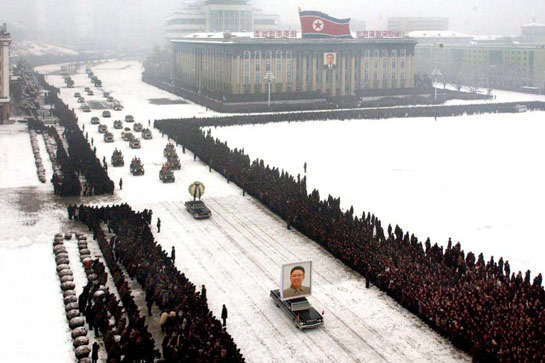Photography and manipulation

You’ve probably seen this image, since it was discussed a little while ago in major media outlets. It’s a manipulated photograph of the burial of the North Korean leader. So we’re talking about manipulation again. I’ve written about this extensively (you can find lots of posts in the archives), and I don’t know how much I want to add to that. (more)
That said, the real issue here, at least as far as I am concerned, is the following. In a news context, there are two types of manipulation going on: First, there is the manipulation of images themselves. Second, there is the manipulation that happens through the use of certain images, while not using other images. I don’t think you can talk about just the first, while pretending the second isn’t an issue.
Note than when I say “manipulate” I’m being incredibly generous with the meaning. In the first case, you manipulate an image even by changing the contrast slightly (some manipulation is allowed, too much is not - big problem, as I discussed in the past). In the second case, you shape people’s opinions or you educate them; and even though we usually don’t think of that as manipulation (at least not when it’s done by our media), it essentially is. This might become most obvious in cases where awareness of an issue needs to be created: Often, you want to manipulate people so they change their behaviour (start buying recycled goods, say).
This second type of manipulation is not the same as the first kind - that’s pretty obvious. Often, the manipulation of the second kind if even more tricky, because it might have to do with an absence of photographs (think of the Bush administration prohibiting photography of caskets of US soldiers coming home - a blatant attempt to manipulate the public’s perception of a war).
But in almost all cases, to judge what damage is being done by manipulation in photography I think we need to look at both types of manipulation, and not just at one. Which means that for the most part we need to talk more about the use of photographs in the media, and to what extent the media are open about it. If the media were perceived as open and honest (which I’m happy to argue is not the case), we would be much less worried about manipulation (regardless of which type we’re talking about).
So what damage is done by using a doctored photograph of that funeral? Well, we should reject manipulated images for reasons of journalistic credibility. But we could easily also just disclose that the image is doctored and use it anyway. After all, the most important facets of the image, the facts, are unchanged: It’s a creepy very Communist funeral, a perfect view into the mindset of a very messed up state ideology. In fact, the manipulation actually makes things even creepier. And we could connect that to the long history of photo manipulation by Communist countries.